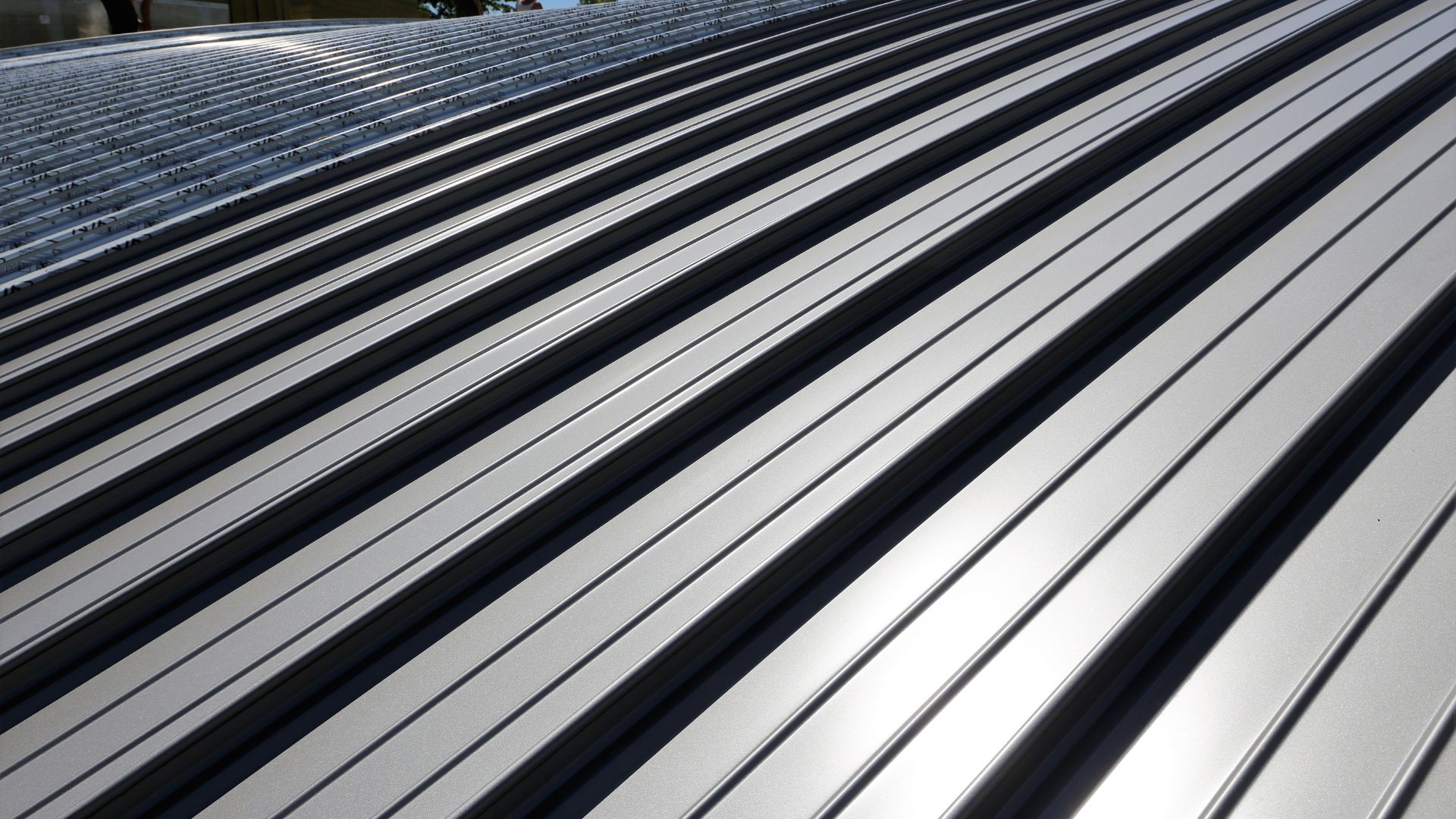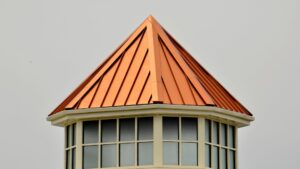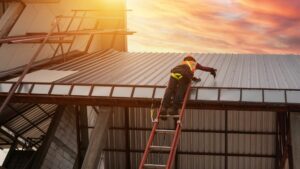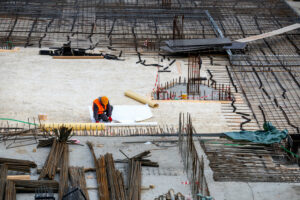Painting your metal roof can seem like a big task. Metal roofs need protection from weather and aging. Our guide offers steps and tips to make your roof look new again. Keep reading for all the details!
Key Takeaways
- Choosing the right type of paint is crucial for protecting the roof against weather damage. Options include acrylic or oil-based paints designed specifically for metal surfaces.
- Applying primer before painting helps improve adhesion between the paint and the metal surface, providing an extra layer of protection against rust and corrosion.
- Regular maintenance, including cleaning and checking for any signs of damage such as rust spots or peeling paint, keeps your painted metal roof in top condition longer.
Painting A Metal Roof
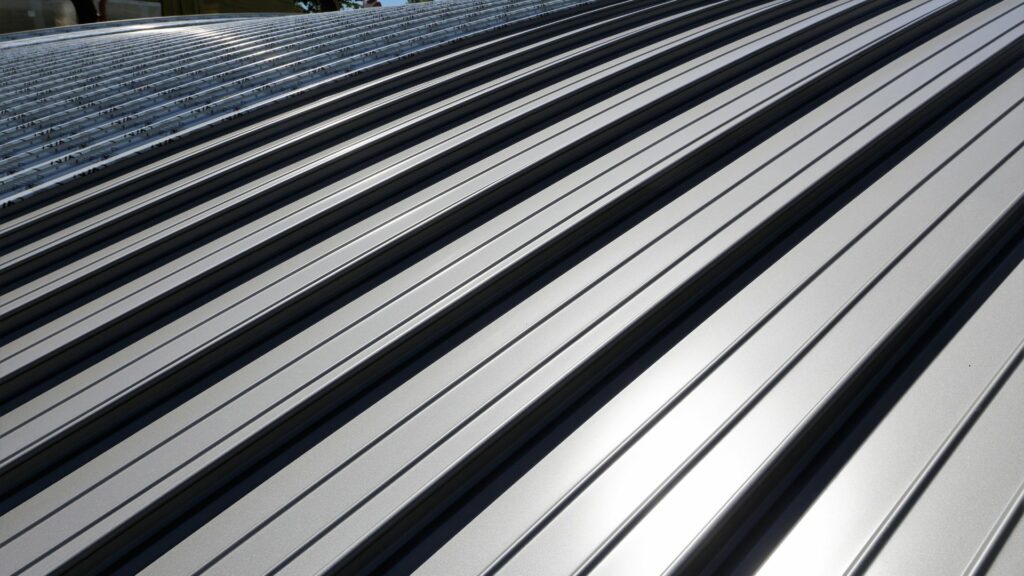
Yes, changing the color of a metal roof is doable. Before adding any new paint, make sure to give the roof a good cleaning for a smooth coat.
Yes, it is possible to change the color of an existing metal roof.
Changing the color of an existing metal roof is a real option for those looking to update their property’s appearance. By selecting the right paint, such as acrylic or alkyd designed specifically for metal surfaces, you ensure both beauty and protection against elements like rust and corrosion.
Effective preparation is key, involving thorough cleaning and applying primer before the new coat of paint goes on.
For this task, choosing equipment wisely plays a big part in achieving a professional finish. Using tools like power washers can help remove dirt and old flaking paint efficiently while ensuring the surface is ready for priming.
Safety gear is crucial too; make sure ladders are secure and harnesses are used if necessary. The process isn’t just about slapping on some color—it’s about making smart choices every step of the way to extend your roof’s lifespan with a fresh look.
Clean the roof before painting to ensure a smooth finish.
After confirming that you can alter the color of your metal roof, it’s critical to focus on cleaning it for a flawless finish. Clearing all dirt, debris, and chipped paint off the surface is vital before applying fresh paint.
Tools like pressure washers or scrub brushes paired with a cleaning mixture make this job easier. Such thorough preparation not only ensures that your new coat adheres well but also guards against rust and corrosion down the line.
This step sets the stage for a durable and visually pleasing result. Use latex or alkyd paint after priming to achieve an excellent outcome on commercial buildings, industrial facilities, or garages.
Regular maintenance, including spotless sweeps and checks for any deterioration, will keep the new paint in top condition longer. Properly prepping and taking care of your painted metal rooftop can significantly prevent future peeling and ensure its long-term appearance remains appealing.
How To Paint a Metal Roof in 8 Steps
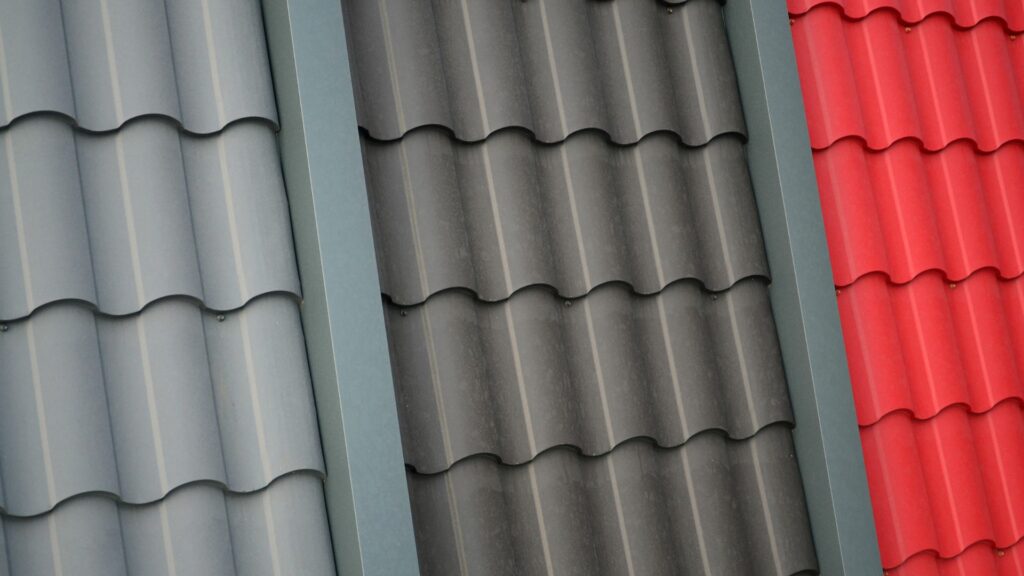
Painting a metal roof brings a fresh look to your building. It requires careful planning and specific steps. First, prepare the surface by cleaning it well and picking a weather-friendly day for the job.
You need to strip off any old covering and clear away rust spots that could ruin your work. Using a high-pressure water spray, clean off all dirt before applying an undercoat meant for metal surfaces.
For painting, choose between oil-based or water-based paint that’s suited for outdoors; both have their benefits in durability and finish. Use rollers or sprays to evenly coat the roof, ensuring you cover every inch thoroughly.
Finish with a sealing product applied with brushes to protect against leaks and extend the life of your paint job.
Keep essential tools like scrapers, pressure washers, rollers, protective gear, and sealant on hand throughout this process. Taking these steps seriously will help maintain the integrity of your metal roof while updating its appearance.
Prep the roof and plan for a dry day.
Start by thoroughly cleaning the roof to get rid of any dirt, leaves, or other debris. A pressure washer can make this job easier and more effective. This step is crucial to ensure that your paint adheres properly and lasts longer.
Check the weather forecast before you begin. You need a clear day with no chance of rain for the best results.
Next, inspect the metal surface for any signs of rust or old peeling paint that needs removing. Use a wire brush or sandpaper to smooth out these problem areas. Applying a primer is essential—it acts as a base coat that helps your final color stick better and adds an extra layer of protection against elements like UV rays and moisture.
Choose a dry day with mild temperatures for painting; extreme heat or cold can affect how well the paint dries and holds up over time.
Remove old paint and rust patches.
To ensure your metal roof gets the best care, removing old paint and rust patches is crucial. Eagle Rivet focuses on these areas to enhance durability and reliability for every project.
Use a scraper or a wire brush to get rid of flaking paint and corrosive spots efficiently. This step prepares the roof’s surface for new coatings, ensuring they adhere better and last longer.
Next, power wash the roof to clean off any lingering debris or dirt. Applying a high-quality primer sets the stage for painting. Choose primers designed specifically for metal surfaces to prevent future rusting and improve paint adherence.
Once you’ve taken care of these preparatory steps, you’re ready to apply primer before moving on to painting.
Power wash the roof and apply a primer.
First, use a high-pressure cleaner to wash the roof. This step is vital for removing all dirt, debris, and old paint. A clean surface ensures the new paint sticks better and looks smooth.
Make sure you cover every inch of the metal rooftop to get rid of any grime or loose materials that could mess up your painting job.
Next, apply a rust-preventing base coat on the cleaned metal surface. Choose a high-quality product that fights rust formation. It’s important to lay this coat down thinly and evenly across the entire area.
Allow it to dry thoroughly before moving on to painting. This layer acts as a sticky note between the metal and paint, improving how well they adhere to each other and extending your roof’s life by keeping rust at bay.
Paint the roof with an oil-based or acrylic-latex paint.
Choose either an oil-based or acrylic-latex covering for your metal roof. Both options offer excellent coverage and durability, making them ideal for withstanding harsh weather conditions.
Oil-based products dry slower but provide a stronger barrier against moisture, which can be crucial in areas with heavy rain or snow. On the other hand, acrylic-latex solutions dry quickly and are easier to clean up since they’re water-soluble.
Applying these coatings requires precise techniques to ensure the best outcome. Use rollers or sprayers designed for exterior surfaces to achieve a uniform layer across the metal surface.
For those hard-to-reach spots or detailed work around fixtures, a high-quality brush will do the trick. Always adhere to two coats for optimal protection and longevity of your roof’s new color.
This method not only enhances the aesthetics of your property but also contributes significantly to extending the life span of your roofing system.
Seal the roof with a brush sealant.
Apply a brush sealant to the roof after painting. This step makes sure your metal roof is waterproof and lasts longer. Use a high-quality brush for an even coat. Go for silicone or polyurethane-based sealants, as they offer the best protection against water and sun damage.
Work in sections to ensure thorough coverage without missing any spots. A good sealant not only extends the life of the paint but also prevents leaks and reduces energy costs by reflecting heat away from your building’s interior spaces.
Always check the weather forecast before starting; it’s best to apply sealant on a day with no rain predicted to allow it enough time to dry completely.
Tips for Maintaining a Painted Metal Roof
Keeping your painted metal roof clean ensures it stays in top shape. Regular checks for any signs of damage like rust spots or paint chips help catch issues early.
Keep the roof clean and free of debris.
Regular cleaning of the roof is crucial for its upkeep and longevity. Use a soft-bristled sweeper or a gentle detergent mix to get rid of dirt and grime without harming the painted surface.
This simple step prevents damage and wards off corrosion, keeping your property’s shelter in top condition.
Trimming overhanging branches from nearby trees also helps reduce debris on the roof. Leaves, twigs, and other organic materials can gather and cause problems over time if not removed.
By performing these tasks regularly, you ensure that your metal shelter remains clean, free from detritus, and less likely to suffer wear or corrosion quickly.
Inspect for any rust or damage regularly.
Make sure to check your metal roof for any rust spots or damage often. This means looking closely at areas where paint might be peeling or chipping off. These spots can let rust start, which leads to bigger problems down the road.
Use a ladder safely to get a good view of the entire roof. Doing this lets you catch issues early and saves you from spending more money on repairs later.
Carry out these inspections at least once every year, especially after harsh weather hits your area. Storms and heavy rains can sometimes harm roofs, making it crucial to spot and fix any new damage quickly.
Keep an eye out for signs of wear and tear that could worsen over time if ignored. By staying ahead with regular checks, you help ensure your painted metal roof lasts longer without needing major fixes.
Touch up any chipped or peeling paint.
Regular inspections of your painted metal roof can catch chipped or peeling paint early. Choose a high-quality metal paint for touch-ups to keep the roof’s protective coating intact.
Clean the damaged area well before starting. This ensures the new paint sticks properly and lasts longer.
Use a primer on these spots to boost adhesion and create an even base for the fresh coat. Depending on the repair size, pick either a brush or spray method for application. Always adhere to the paint manufacturer’s guidelines for applying and drying times, securing long-lasting protection against weather wear and tear.
DIY vs. Hiring a Professional
Choosing between DIY and bringing in a pro depends on what you know and the gear you have. If you’re good with your hands and have brushes, ladders, and safety harnesses, you might tackle the project yourself.
Still, hiring a skilled roofer guarantees top-notch work that lasts years.
Consider your skill level and safety precautions.
Painting a metal roof is no small task. It demands skills and experience that not everyone has. You must weigh your own abilities before deciding to tackle this project on your own.
If you are not fully confident, reaching out to a professional roofer might be the best route. They have the training and tools needed to do the job safely and effectively.
Safety is another critical factor that cannot be ignored. Working at heights comes with its risks, such as falls or injuries from handling heavy equipment. Ensure you have the right safety gear like harnesses, ladders, and protective clothing before starting.
Also, understanding how to use these tools correctly will help prevent accidents on the roof. If any of this feels beyond your comfort zone, it’s wise to consult with a pro who deals with these hazards daily.
Research and gather necessary supplies and tools.
Before starting your metal roof painting project, take time to research and understand the materials you’ll need. This step is crucial for both DIY enthusiasts and professionals alike.
You will need primer, oil-based or acrylic-latex paint, brushes, rollers, and essential safety gear like protective clothing and goggles. It’s important to choose supplies that match the type of metal roof you have and its condition.
Next, learn about surface preparation requirements to ensure a strong bond between the paint and your roof. Selecting the right type of paint for metal surfaces can make a big difference in the outcome of your project.
Don’t forget about safety equipment; it’s vital for protecting yourself during the job. With all necessary tools in hand, you’re ready to move on to preparing your roof for painting.
Hiring a professional may ensure a longer-lasting and professional finish.
After gathering all the necessary supplies and tools, you might think about whether to tackle the job yourself or get a professional. Hiring a professional painter could be your best bet for a top-notch finish on your metal roof.
These experts come with the right gear and know-how to do an excellent paint job that lasts long. They use special techniques and quality products that make sure your metal roof looks fantastic for years.
Professionals save you both time and energy. They handle everything with skill, from preparing the surface to applying the final coat of paint. Their experience allows them to work swiftly and effectively, delivering results that are hard to achieve on your own.
Plus, they already have all the equipment needed, so you won’t have to spend extra on buying or renting tools like brushes, pressure washers, or ladders specifically meant for such jobs.
Conclusion
Painting a metal roof can boost its look and protect it against weather. A clean, prepped surface makes paint stick better. Choosing the right paint, like high-quality acrylic ones made for metal tops, is key.
This choice keeps the roof safe from rust and heat damage. For those tackling this project, taking safety steps and possibly chatting with a pro improves results.
Keep painted roofs looking good by cleaning them often and checking for any wear or peeling spots to fix them quickly. Doing these maintenance tasks helps your roof last longer and work better.
Taking on a painting project like this might seem big but following simple steps makes it manageable.
Using reflective coatings could cut down on heat absorption, making your building cooler and saving energy costs in some cases.
A well-done painting job not only extends the life of your metal top but also adds value to your building by enhancing its appearance.
Finally, consider how this change improves your property both visually and functionally while keeping in mind proper care will ensure lasting benefits.
FAQs
1. Can I use any type of paint on my metal roof?
No, you should not use just any paint. It’s important to choose a special kind of paint that sticks well to metal and can handle different weather conditions.
2. Do I need to prepare the surface before painting my metal roof?
Yes, preparing the surface is crucial. Make sure to clean it thoroughly and remove any rust or old paint for the best results.
3. Is it okay to paint over shingles on a metal roof?
Painting over shingles is not recommended because they require different treatment than smooth metal surfaces for painting.
4. How often should I repaint my metal roof?
You don’t have to repaint too often if you do it right the first time with quality materials and proper preparation; usually, every 10 years or so will keep your roof looking good.

David Nietch graduated from Central Connecticut State University with a Bachelor of Science in Business Management and Organization. He has a strong background in positions which require experienced operation and project management as well as a strong attention to detail. David has a profound knowledge of concepts, competitive products, practices and process dealing with the roofing market. David excels at building highly effective working relationships with clients, technicians, managers and vendors.
